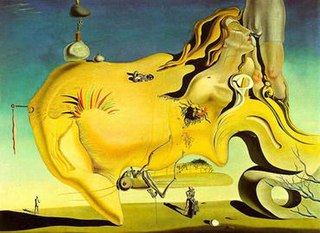The Great Masturbator
| The Great Masturbator | |
|---|---|
 | |
| Artist | Salvador Dalí |
| Year | 1929 |
| Medium | Oil on canvas |
| Movement | Surrealism |
| Dimensions | 110 cm × 150 cm (43.3 in × 59.1 in) |
| Location | Museo Nacional Centro de Arte Reina Sofía, Madrid |
The Great Masturbator (1929) is a painting by Salvador Dalí executed during the surrealist epoch, and is currently displayed at Museo Nacional Centro de Arte Reina Sofía, Madrid.
Description[]
This section needs additional citations for verification. (March 2012) |
The centre of the painting has a distorted human face in profile looking downwards, based on the shape of a natural rock formation at Cap de Creus along the sea-shore of Catalonia.[1] A similar profile is seen in Dalí's more famous painting of two years later, The Persistence of Memory. A nude female figure (resembling Dalí's then new muse, Gala) rises from the back of the head; this may be the masturbatory fantasy suggested by the title. The woman's mouth is near a thinly clad male crotch, a suggestion that fellatio may take place. The male figure seen only from the waist down has bleeding fresh cuts on his knees. Below the central profile head, on its mouth, is a grasshopper, an insect Dali referred to several times in his writings. A swarm of ants (a popular motif representing sexual anxiety in Dalí's work) gather on the grasshopper's abdomen, as well as on the prone face. In the landscape below, three other figures are arranged, along with an egg (commonly used as a symbol of fertility) and sparse other features. Two of the characters in the landscape are arranged in such a way as to cast a long single shadow, while the other character is seen hurriedly walking into the distance on the peripheries of the canvas. On the back of the central head figure, a formation of two rocks and a potted dry plant can be seen, the pot of the plant placed over the bottom rock while balancing the other rock on top of it in an unrealistic way. This part is thought to represent the escape-of-reality idea found in many of Dalí's other works.

Interpretation[]
The painting may represent Dalí's severely conflicted attitudes towards sexual intercourse. In Dalí's youth, his father had left out a book with explicit photos of people suffering advanced untreated venereal diseases to "educate" the boy. The photos of grotesquely damaged diseased genitalia fascinated and horrified young Dalí, and he continued to associate sex with putrefaction and decay into his adulthood.[2]
In that privileged place, reality and the sublime dimension almost come together. My mystical paradise begins in the plains of the Empordà, is surrounded by the Alberes hills, and reaches plenitude in the bay of Cadaqués. This land is my permanent inspiration. The only place in the world, too, where I feel loved. When I painted that rock that I entitled The Great Masturbator, I did nothing more than render homage to one of the promontories of my kingdom, and my painting was a hymn to one of the jewels of my crown.
Comparisons have been made to Hieronymus Bosch's The Garden of Earthly Delights. The Great Masturbator is similar to an image on the right side of the left panel of The Garden of Earthly Delights composed of rocks, bushes and little animals resembling a face with a prominent nose and long eyelashes.[4]
History[]
Dalí kept the painting in his personal collection, displayed at the Dalí Theatre and Museum in Figueres, willing it to the national collection of Spain upon his death, when it was removed to the Madrid museum.[5]
See also[]
References[]
- ^ Ian Gibson, "The Shameful Life of Salvador Dalí", W.W. Norton & Company, 1987. ISBN 0-393-04624-9. Page 71, pages 256 - 257, plate XIV
- ^ Edward Rubin "The Great Masturbator In Retrospect: Salvador Dalí at the Philadelphia Museum of Art" NY Arts Magazine [1]
- ^ Dalí, S., Confessions inconfessables. A: Obra Completa, Textos Autobiogràfics 2. Ediciones Destino / Fundació Gala-Salvador Dalí, Barcelona / Figueres, 2003, p. 463.
- ^ Félix Fanès: Salvador Dalí. The Construction of the Image 1925–1930. Yale University Press 2007, ISBN 978-0-300-09179-3, p. 74
- ^ Busquets, Jordi; Navarro Arisa, J.J. (30 January 1990). "El legado de Dalí se divide en dos bloques, con 56 obras para Madrid y 134 a repartir en Cataluña" [Dalí's legacy is divided into two blocks, with 56 works to Madrid and 134 to be distributed in Catalonia]. El País (in Spanish). Retrieved 29 March 2012.
External links[]
- 1929 paintings
- Erotic art
- Insects in art
- Paintings by Salvador Dalí
- Paintings in the collection of the Museo Nacional Centro de Arte Reina Sofía
- Spanish art
- Surrealist paintings